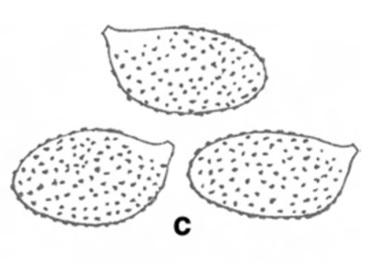Index Fungorum number: IF551439 Facesoffungi number: FoF00999
Etymology: The name refers to the unpleasant smell of the basidiomata.
Holotype: T. Niskanen 07-411 (H). Pileus 30–90 mm, hemispherical, then low convex to plane, purple when young, later very pale purple to almost whitish, viscid. Lamellae medium spaced, adnexed to emarginated, at first purple, later strong brown. Stipe 50– 130 mm long, 6–10 mm thick at apex, 6–13 mm at base, cylindrical to somewhat clavate, pale purple when young, later very pale brown to whitish silky fibrillose. Universal veil white, thin, forming some complete and/or incomplete girdles on the stipe. Basal mycelium white. Context at first purple later strong yellowish brown. Odor of lamellae unpleasant. Basidia 4-spored. Basidiospores 8.8–9.5(−10)×5–5.7 μm (av. = 9.2× 5.4 μm, 40 spores, 2 specimens), Q=(1.55–)1.6–1.8(−1.85) (av. = 1.71), amygdaloid to somewhat ellipsoid, finely and densely verrucose, almost indextrinoid to somewhat dextrinoid. Lamellar trama hyphae smooth, somewhat yellow in Melzer’s reagent. Cheilocystidia 35–45×7–13 μm, cylindrical to weakly lageniform. Pileipellis. Hyphae in the surface layer 3–7 μm wide, in gelatinous substance, hyaline, with granulose contents. Hyphae under the surface layer 5–10 μm wide, hyaline, not encrusted. ITS sequence (GenBankKR011124, holotype) distinct from the other members of Camphorati, and differing from them in the ITS region by more than 10 substitutions and indel positions.
Ecology and distribution: In mesic coniferous forests (Tsuga, Abies, Pseudotsuga, Picea). Producing basidiomata in autumn. Rare, to date known from Washington and California in western North America.
Material examined: USA, California, Humboldt Co., Redwood National Park, coniferous forest, leg. J. Olsson & K. Liimatainen, T. Niskanen 12-230 (H). Washington, Olympic peninsula, Olympic National Park, surroundings of Sol Duc camp ground, coniferous forest (at least Tsuga heterophylla), 6 October 2007, leg. K. Liimatainen & T. Niskanen 07-411 (holotype, H), (isotype, NY).
Notes: Cortinarius putorius belongs to /Camphorati. The group is characterized by the purple to almost white basidiomata, unpleasant smell, and distinct cheilocystidia. The closely related C. camphoratus (Fr.) Fr., which also occurs in the coniferous forests of the Pacific North West, has less purple basidiomata, the universal veil is at first pale bluish violet, and the spores are larger (9–)9.5– 10.5×(5.5–)6–6.5 μm.


